Summary, abstract and full texts n° 100
Philippe Mesnard, Yannis Thanassekos: Témoigner. Entre Histoire et Mémoire. Revue pluridisciplinaire de la Fondation Auschwitz (pdf in French)(pdf in Dutch)
Dossier: Questions de « bourreaux »
Coordinated by Philippe Mesnard and Yannis Thanassekos
Philippe Mesnard: Editorial(pdf in French)(pdf in Dutch)
Benoît Cazenave: La Mégère de l’Armagedon (pdf)
- After 1945, Ilse Koch was indicted for numerous crimes committed against the prisoners of KZ. She was further accused, albeit without proof, of numerous other crimes including the creation of objects made with human skin and sexual deprivation, and in the context of the Cold War and denazification her trials became symbols of german democratisation and exoneration, and of the feminisation of nazi ignominy. After having served as a muse for numerous works of sado-eroticism and nazi fascination in the 1960s and 1970s, she remains a reference point in "feminine violence" and an instrument of negationist propaganda.
Regula Christina Zürcher: Massacreur et père : un paradoxe apparent (pdf) [Parent and mass-murderer: an apparent paradox with a system]
-
Parent and mass-murderer - an apparent paradox with a system Using the records of the Auschwitz Kommandantur, the memoirs of SS personnel and their trial statements, descriptions by prisoners and the research carried out to date, this article describes the family life of the SS members who ran the mass killing installations at Auschwitz. It shows that the presence of their wives and children was essential for enabling the SS and the murder machine to function The families, who lived a pleasant and varied life in the SS quarters, provided the criminals with distractions and rewards which enabled them to forget their "work" of killing and believe that their activities were normal.Using the records of the Auschwitz Kommandantur, the memoirs of SS personnel and their trial statements, descriptions by prisoners and the research carried out to date, this article describes the family life of the SS members who ran the mass killing installations at Auschwitz. It shows that the presence of their wives and children was essential for enabling the SS and the murder machine to function. The families, who lived a pleasant and varied life in the SS quarters, provided the criminals with distractions and rewards which enabled them to forget their "work" of killing and believe that their activities were normal.
Régine Waintrater: Les Bienveillantes, intimité forcée ou intimidation ? (pdf)
- Jonathan Littell's novel, Les Bienveillantes [The Kindly Ones] is based on a strategy emanating from its author and functioning within the text itself as a means of perverse seduction. To this effect, both the author and Max Aue's story (Aue is the main character as well as the narrator, who relates his life as a member of the SS at the Eastern Front, in Berlin and in the Nazi camps) make profuse use of entanglements of extreme violence, sexual aberration and transgressive scenes. The paradox is that this novel has been celebrated as a new breakthrough in the discovery of the mechanisms of the Shoah through the prism of a perpetrator's mind, while major investigations on the real individuals guilty of such crimes reveal that this character lacks all plausibility. The actual perpetrators remain silent, but this one is a great talker.
Charlotte Lacoste: De la vigilance critique (pdf)
- Jonathan Littell's novel was widely acclaimed by the French critics, and many of them did consider the book as the first literary masterpiece of the 21st. century. Aware that Les Bienveillantes did not distinguish itself by its literary qualities, the critics generally advanced two arguments to justify their craze: the documentary work on the one hand, and the narrative device on the other hand. This article intends to deliver a critical analysis of textual devices used in Les Bienveillantes and to enlighten the intertexts to which the author resorts and the strategies of seduction he displays towards the public in order to darken the understanding of the Shoah.
Pierre Ayçoberry: Autoportrait d’un fanatique en quarante mille pages : le Journal de Joseph Goebbels 1923-1945
-
Goebbels kept a daily journal for twenty two years in which he noted the day's activities, and remarks made by his friends, enemies, and master. Following half a century of unexpected disappearances and reappearances of partial or erroneous versions of the journals, a definitive 29 volume edition was finally published between 1993 and 2005 thanks to the perseverance of the members of the Munich Institut für Zeitsgeschichte. An abridged French edition in four volumes is in progress, of which the first three installations have already been published.
The volume of information that these pages provide on the internal workings of the Party, and subsequently the Nazi regime, clearly needs to be approached critically and not simply taken at face value. The very nature of the manuscript (a personal diary) implies that the author presents himself to posterity as consistently being the most lucid and faithful of the Führer's acolytes on both good days and bad.
It is precisely this professed fidelity which guarantees that he transcribed both Hitler's rages and his rational analyses with the same scrupulous care. The reader is thus able to study two fanatics, almost inseparable from their first to their last encounter.
Pierre Thys: Approche criminologique du criminel de guerre contemporain (pdf)
- Through the medium of illustrative cases drawn from contemporary armed conflicts it becomes possible to study "executioners" by taking recourse to criminology, and more particularly to criminal psycho-sociology. The war criminal could very well vary only in degree, and not in nature, to the criminal of common law. He certainly seems more "normal" than the socially disengaged criminal, but this difference becomes less clearly defined as soon as the process leading up to the crime and permitting its repetition is placed under closer scrutiny. We can thus show that the war criminal can certainly benefit from criminology in order to explain actions and their genesis. Whilst the criminal’s convictions take primacy, the crime itself, whether motivated by opportunism, profit, or ideology, remains a crime without glory, and he who commits it a criminal conscious of his actions.
Laurent Thiery: La « Gestapo de Lille » (1940-1944) : histoire et représentation
- Between 1940 and 1944 a branch of the Sipo-SD operated in Lille against the Jews and the Resistance, under the supervision of OFK 670. Although it had few staff and was largely subordinate to the army, the "Gestapo of Lille" came to epitomise the image of the Nazi torturer in post-war collective memory. This image is examined through a study of these men and their work.
- Even though the Auffanglager in Breendonk and the Polizeiliches Durchgangslager in Amersfoort differ in several aspects (among which are the small size of the first and the fact that the second also served as a training camp for young SS recruits), they have in common that they both used autochthonous as well as German guards. It is hence possible to draw comparisons regarding the evolution of their respective staffs during the conflict (division of tasks, number ...) and with respect to the - often violent - methods which were used.
Moreover, the main "perpetrators" of both camps were brought to trial and it is quite interesting to compare the procedures and the sentences pronounced, as well as to establish parallels between the reactions of public opinion in each of the two countries involved.
Frediano Sessi: Criminels par procuration ? Sur l'auto-administration des détenus dans les Lager (pdf) [Criminals by proxy? Prisoner self-government in the camps and delegation of power by the SS]
- The delegation of power to those prisoners whom Himmler in a summer 1944 speech called the army of "my non-commissioned officers" began in 1933 at Dachau with the appointment of an barrack assistant (Feldwebel) and an assistant for the work brigade (Arbeitsfeldwebel). During this period the prisoners delegated with powers of organization and punishment were German criminals.
Subsequently prisoner accomplices were chosen according to the organisational system of the camp, which was divided into five departments (six from 1942) and gave rise to such figures as the Lagerälteste (the camp’s chief prisoner), the Blockälteste (the head of a block), Stubenälteste or Stubendienste (servants in the barracks) and the kapos (responsible for a work brigade) or deputy kapos, not forgetting the army of Schreiber who kept the archives up to date, or the interpreters (Interpreten), the messagers (Läufer), the kitchen kapos (prisoners in charge of the kitchens) or the nursing staff in the Revier. The prisoners in the special brigades who worked in the crematoria and gas chambers in the extermination camps (Sonderkommando) deserve a section to themselves. To quote Rousset, these prisoners formed the camp aristocracy. And yet they included not only cruel collaborators and killers, but members of the resistance who struggled to save many of their comrades, as shown by the example of the "protective militia" formed by the red triangle kapos in Buchenwald. Many acts of resistance by privileged prisoners (known by the general term of kapo) are still little known today, and there is as yet no account of the system in the Nazi camps which describes the full complexity of the structure of society in the camps, using also the testimony of kapos.
Other subjects
Susanne Wein: Antisémitisme dans les mouvements ouvriers des années 1920 ? Enquête sur la presse ouvrière de Brême de 1924 à 1928
-
This article examines the previously neglected issue of the attitude of the left, specifically the KPD and SPD in Bremen, when confronted with anti-Semitism. The work is based on the theory that after the Empire, anti-Semitism became a universal cultural code used in interpreting the world and society as a whole.
After reviewing the common history of the socialist parties until the First World War, the article focuses on selected specific anti-Semitic events that took place in Bremen during the Weimar Republic.
In order to deduce contemporary attitudes the author has chosen to analyse the left wing parties' daily newspapers dating from the relatively calm period from 1924 to 1928. Trends and patterns are illustrated that permit an analysis that goes beyond Bremen. In its perpetuation of a manichaen world-view the KPD demonstrated a structural tendency not only to not recognise anti-Semitic themes but also to produce them themselves. This always occurred through the evocation of the "rich Jewish capitalist". In conjunction with this image the papers peddled conspiracy theories in which their clientele were stylised as victims. The party line of not distinguishing between Jewish and Christian capital was constantly contradicted in practice. In the SPD, the cultural convention of anti-Semitism was also manifest. The party was certainly scandalised by anti-Semitic messages and activity, but unpremeditated themes appeared. The SPD evoked the ironic stereotype of "typically Jewish" against their right-wing adversaries, without recognising the underlying implications of using the image. According to party rhetoric, Jews had to remain beyond reproach. In reality, the SPD didn't hesitate to use anti-Semitic images.
Chris Gastmans, Maria Berghs & Bernadette Dierckx de Casterlé: Verantwoordelijkheidspraktijken en verpleegkundigen gedurende de euthanasieprogramma’s van Nazi-Duitsland (1939-1945)
- The present article examines the context of the moral decisions made by nurses working within the euthanasia programme of Nazi Germany between 1939 and 1945. Our reference frame is Margaret Urban Walker's philosophical model, and especially the hypothesis according to which morality consists of a set of responsible practices. In this way, we try to map how nurses conceived their own responsibilities in the euthanasia programme. First, we will sketch the euthanasia programme in Nazi Germany between 1939 and 1945 and the part nurses played in it. This outline will show how the nurses' responsibilities have been manipulated. Subsequently, we will study nursing as a moral practice in the specific context of the euthanasia programme's ideas and practices regarding responsibility. In the third place, we will examine the reasons wich were offered by the nurses to escape all responsability. Fourthly, we will try to determine whether nurses bore indeed some responsibility in the euthanasia programme. In conclusion, we will discuss the historical pertinence of an ethical reflection on the moral responsibility of nurses who are nowadays confronted with euthanasia.
Hélène Piralian: En quoi le génocide met-il à l'épreuve les fondements mêmes de la psychanalyse ? Les sites rwandais
The journal is available on line at
openedition.org
All issues
-
No. 139 (10/2024) The Liberation
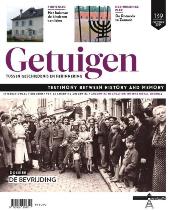
On the occasion of the eightieth anniversary of the liberation of Belgium, We are dedicating a theme issue of our magazine to the country's liberation.
Table of contents (French version)
Table of contents (Dutch version)No. 138 (04/2024) Trials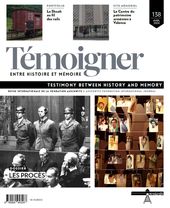
This dossier will deal with trials that have provided a legal answer to a demand for justice. Several cases will be addressed ranging from Istanbul and the Nuremberg Doctors' trial to the German policemen of the Brussels Jewish section and the gacaca trials in Rwanda.
Table of contents (Dutch version)
Table of contents (French version)No. 137 (10/2023) Children's Literature in Light of the Holocaust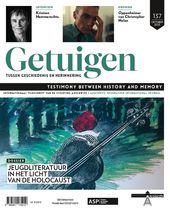
In France and Belgium, research into the relationship between children's literature and the Holocaust is rare, in contrast to the phenomenal attention in America (everyone knows Art Spiegelman's Maus) and in other English-speaking countries. Yet children's books depicting the Holocaust in words and pictures have been steadily gaining ground in post-war France and Belgium. While literary criticism and research still seem to be in their infancy, this dossier will show that critical analysis of this corpus is highly relevant for the future.
Table of contents (Dutch version)
Table of contents (French version)No. 136 (04/2023) The Executioners
The executioner has always fascinated and frightened. The perpetrators of mass crimes are those who carry out, facilitate or order the annihilation of a specific group. Issue 100 of Testimony: Between History and Memory, published in September 2008, examined the Nazi executioners. This dossier offers readers a historical and criminological approach to other genocides of the 20th century.
Table of contents (Dutch version)
Table of contents (French version)No. 135 (10/2022) Disobedience
This issue looks at the concept of disobedience in wartime. While the concept of civil disobedience may seem familiar in these times of endemic protest, there was a time when obedience was the rule. In a military context, disobedience was frequently followed by deadly consequences. This dossier focuses on three cases from the First World War and one from the Algerian War (1954-1962).
Table of contents (Dutch version)
Table of contents (French version)No. 134 (04/2022) The Killing of the ‘Useless’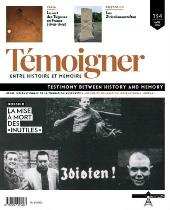
During the Second World War, the Nazi regime didn't just try to destroy the Jewish "race", which it considered dangerous. Before implementing the Final Solution, the Nazis massacred those who didn't fit in with their eugenic racial ideology and whom they considered inferior. In this dossier, we focus on the mentally and physically handicapped, systematic victims of Nazi pseudo-medical madness throughout the world conflict.
Table of contents (Dutch version)
Table of contents (French version)No. 133 (10/2021) 1918-1938: The politicisation of music in Europe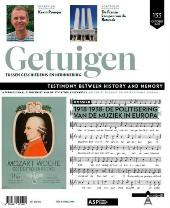
1918-1938: The politicisation of music in Europe
This dossier looks at the instrumentalisation of music by the political world between the wars. The cases are numerous and shed light on the way in which political propaganda was propagated in European musical culture.
Table of contents (Dutch version)
Table of contents (French version)No. 132 (04/2021) AKTION REINHARDT and AKTION ERNTEFEST
AKTION REINHARDT and AKTION ERNTEFEST
The Aktion Reinhardt saw approximately 1.8 million Polish Jews perish in the gas chambers of Bełżec, Sobibór, Treblinka and Majdanek between March 1942 and November 1943. The Jews who ‘escaped’ the gas chambers were shot in Majdanek, Trawniki and Poniatowa on 3 and 4 November 1943 during Aktion Erntefest. The dossier we are proposing takes stock of current research on the Aktion Reinhardt. This historical event has experienced a resurgence of interest among historians of the Shoah over the last fifteen years, thanks, among other things, to archaeological advances at the various sites concerned. We have come a long way since Yithzak Arad's pioneering work in 1987: Belzec, Sobibor, Treblinka: the Operation Reinhard Death Camps. The dossier highlights different perspectives to discuss current research related to the issue. It addresses the erasure of traces, the sociological perspectives of the executioners, the excavation of extermination sites and the most recent historiography.
Table of contents and abstracts (Dutch version)
Table of contents and abstracts (French version)No. 131 (10/2020) Historiography of the Second World War in the Far East
Historiography of the Second World War in the Far East
For many people, 8 May 1945 and the surrender of Nazi Germany is the final chapter of the Second World War. However, it is often forgotten that the months between May and September 1945 were decisive for the future of the world, as fierce fighting continued in the Pacific between the United States and the Japanese Empire until the latter’s unconditional surrender on 2 September 1945, the actual date of the end of the Second World War.Table of contents and abstracts (Dutch version)
Table of contents and abstracts (French version)No. 130 (04/2020) Reception of the Shoah and mentalities in Jewish and Christian circles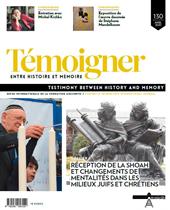
Reception of the Shoah and mentalities in Jewish and Christian circles
The reception of the Shoah has become, for all of humanity, a place of questioning and awareness. This dossier will aim to establish and evaluate the modalities and challenges of the transmission of the Shoah and to measure the resulting changes in identities and mentalities. What were the Catholic views on Judaism before and during the Shoah? What Jewish liturgies and interreligious rites exist for the commemoration of the Shoah in Israel and the United States? The evolution of mentalities in the Jewish world in relation to the Shoah will also be exposed through the analysis of the so-called Bitburg controversy, triggered by the visit of the American President, Ronald Reagan, to the German military cemetery of Bitburg (FRG) in May 1985. The Auschwitz Carmel affair (1985-1993) finally reveals the involvement of the Belgian and French Churches in the resolution of the conflict and is undoubtedly a key stage in the Church's 'teaching of esteem' with regard to the Jews. The historical answers provided in this dossier to the question of the Shoah may be decisive for the survival of Judaism and the relationship between Judaism and Christianity.
Table of contents and abstracts (Dutch version)
Table of contents and abstracts (French version)No. 129 (10/2019) Recognition of victims
Recognition of victims
In recent decades, the idea has gained ground that victims of mass crimes deserve recognition. This has become an essential category of our memorial culture. This dossier aims to take stock of this issue by looking at the broad spectrum of measures to ensure recognition, from simple remembrance to targeted judicial interventions, and by recalling the growing importance of the victim in international criminal justice. It returns to the problematic aspects of recognition when it leads to competition among victims.
Table of contents and abstracts (Dutch version)
Table of contents and abstracts (French version)No. 128 (04/2019) 25 years on, how to remember the Tutsi genocide
Kwibuka [Remember]. 25 years on, how to remember the Tutsi genocide
April 1994. Images of mutilated bodies are projected on European screens, originating from Rwanda. 25 years later, we remember.Table of contents and abstracts (Dutch version)
Table of contents and abstracts (French version)No. 127 (10/2018) Perpetuation of violence after 1918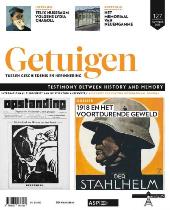
Perpetuation of violence after 1918
One hundred years ago, the First World War ended in November 1918. After four years of bloodshed, peace returns to Europe. At least, that was the impression of the victors at the time, and today it is also the impression of the commemorators who celebrate its centenary. The historical reality is more complex. At least until 1923, violence continued in the form of revolutions and counter-revolutions, wars and civil wars. The spirits also remain in the grip of violence on both the left and the right. The dossier proposes to define the contours of this Europe so strongly marked by the Great War, by evoking the culture of violence established by it and which, finally, degenerated into the total explosion of the Second World War.
No. 126 (04/2018) Questions about the future of remembrance work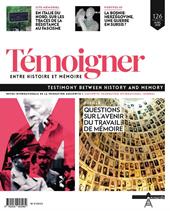
Questions about the future of remembrance work
On 20 and 21 January 2017, the seminar ‘Questions on the future of remembrance work’ was held in Esch-sur-Alzette, Grand Duchy of Luxembourg. The five articles in this dossier taken from the conference proceedings attempt to answer the following questions: How can we build a critical memory of the Shoah, free of myths and national fragmentation? How do we anticipate the absence of direct witnesses? In the future, who transmits what, and how?
No. 125 (10/2017) Persecution of homosexuals by the Nazis
Persecution of homosexuals by the Nazis
Historical knowledge of the Nazi persecution of homosexuals and their deportation has made significant progress in recent years due to the increase in research on the subject. In this dossier, recognised researchers as well as young doctoral and PhD students take the floor. The insights they provide concern both the question of the singular destiny of homosexual men and women during the Second World War and the way in which the memory of the homosexual victims of Nazism has evolved since the end of that war.
No. 124 (04/2017) Music in the camps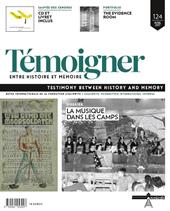
Music in the camps
Music was an integral part of the concentration camp world, Nazi and otherwise. What kind of music was composed and performed, and what exactly was its role in the camps? A factor of survival and resistance for the prisoners, a way for them to express their hope and their humanity - or, on the contrary, an instrument of oppression exploited by the executioners? What is the function of music in the work of memory following the experience of extreme violence and suffering? This dossier proposes to explore these issues.
No. 123 (10/2016) Translating Memory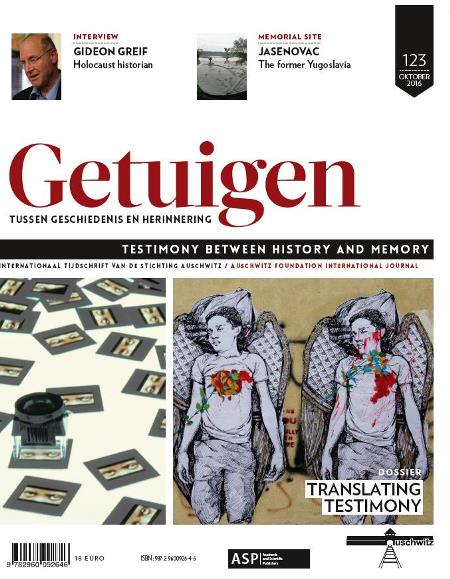
Translating Memory
Presentation of the dossier: What is the relationship between testimony, defined as a more or less ritualized firstperson account of political violence, and translation? Correspondingly, how does the translator position herself towards the witness? Can the translator be, or become, a witness? How, when and why are testimonies translated? Which linguistic and discursive strategies do translators resort to when faced with ethically challenging texts? Which role do they play exactly in the transmission of the historical knowledge, cultural values or social critique conveyed by the testimony? Does translation weaken or rather reinforce the relevance and impact of the original statement? How important is translation in literary, political and institutional settings? Do these specific settings determine translation practice in significant ways? To which extent can subsequent processes of transcription, editing, translation and archiving affect the source text? And how accurate are the boundaries we draw to distinguish witnessing from translating, documentary from literary testimony, the original from its translation? These are the main questions we intend to explore in our dossier.
No. 122 (04/2016) Revisionism and negationism
Revisionism and negationism
Strictly speaking, Holocaust denial is the ‘doctrine denying the reality of the Nazi genocide of the Jews, including the existence of the gas chambers’; by extension, the term refers to the denial of other genocides and crimes against humanity. The literature on Holocaust denial is extensive. There are studies on the subject in many countries as well as biographies of deniers. The argumentative and rhetorical strategies of the deniers have been widely deciphered. Websites systematically dismantle their fallacies. While there is no shortage of reliable information on the phenomenon, it is essential to return to it again and again, for several reasons.
No. 121 (10/2015) Extreme violence on stage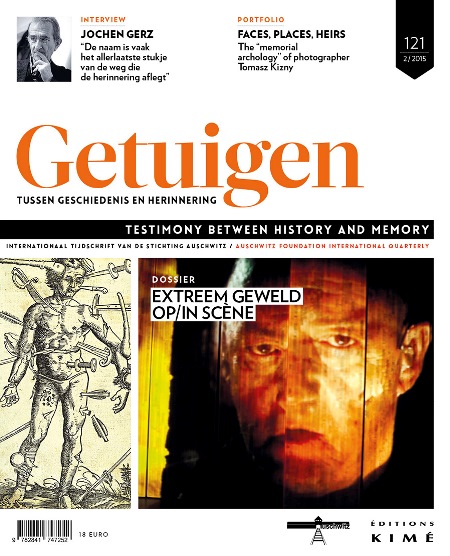
Extreme violence on stage
Extreme violence shows itself. It bursts through the screens. It surfs from one style and medium to another: news reports, documentaries, fiction, arts of all kinds. Yet theatre distinguishes itself from this mêlée all while constantly returning to the subject. Differently. Linked from its origins to the representation of cruelty and having “miraculously” escaped the often sterile polemics on the interdiction (or not)... of representing the Holocaust, it is still with the same youthfulness that theatre deals with extreme violence today, relentlessly pursuing the articulation of ethics and aesthetics.
No. 120 (04/2015) What future is there for the memory of the Armenian genocide?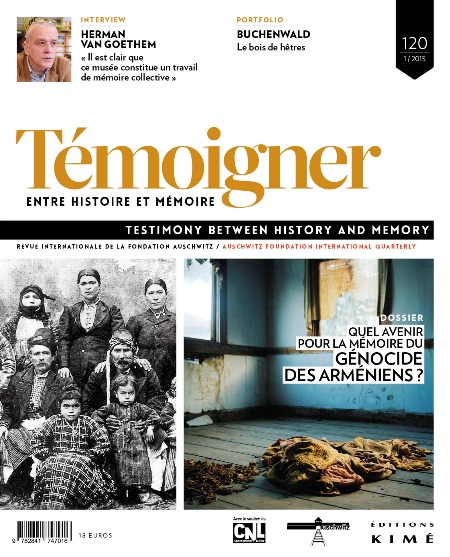
What future is there for the memory of the Armenian genocide?
The 1915 genocide of Turkish Armenians still stirs up numerous debates, controversies, declarations of principle, statements and counter-statements, and even negation. However, as we speak, ties are being established more and more openly, bridges are built and bonds strengthened between the Armenian and Turkish communities. Is reconciliation possible?
No. 119 (12/2014) 70 years ago, Auschwitz. Looking back on Primo Levi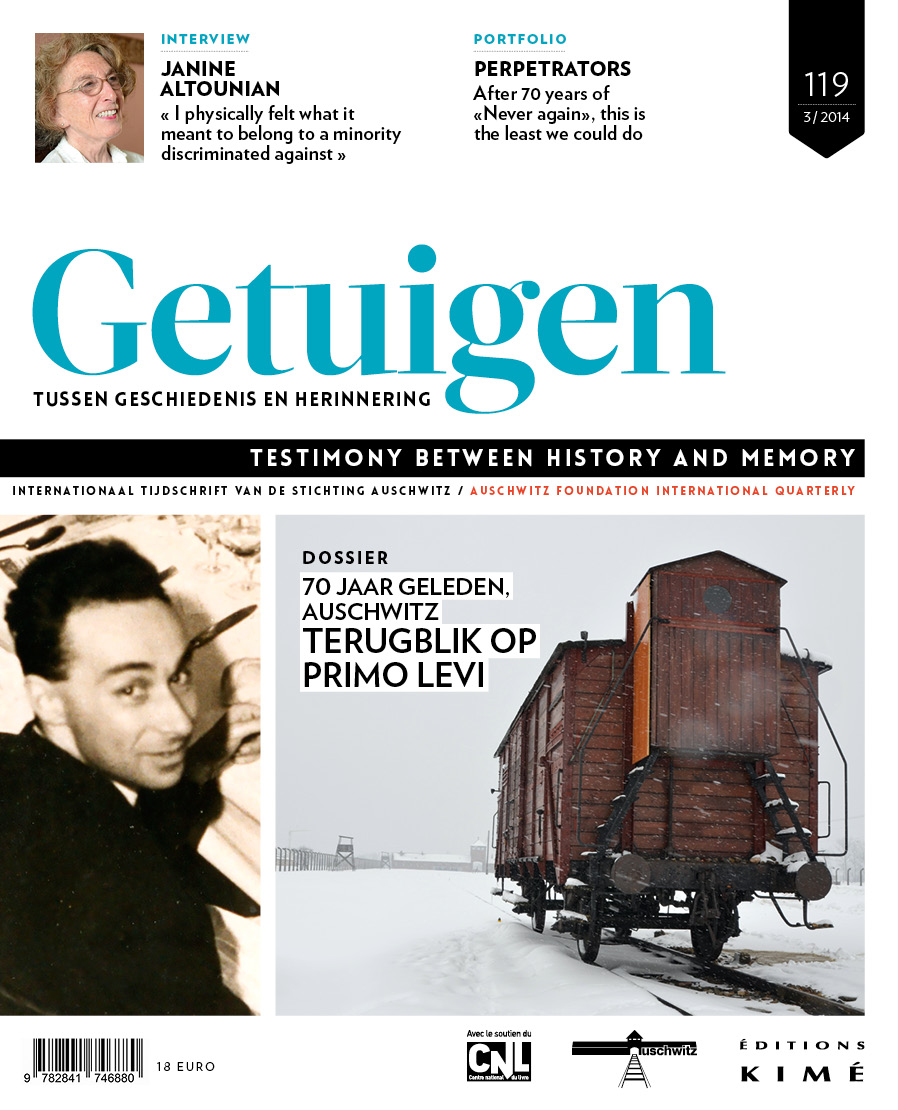
70 years ago, Auschwitz. Looking back on Primo Levi
27 January 1945. Seventy years ago the first soldiers of the Red Army marched into Auschwitz. One might argue that the camp was “liberated” then, but the truth is that neither Auschwitz, nor any of the other Nazi camps, was ever a priority to the Allied Powers. Primo Levi was one of the few survivors who knew how to hide and escape the enforced evacuation of the camps. With this dossier, we want to cast light on the complex figure that Levi was: a Jew, a deportee, a chemists, a witness, and a writer. It sets out to study his oeuvre and his interpretation of the notions of “resistance” and “engagement”, in order to understand how he eventually became a “professional survivor”, as he once described himself.
No. 118 (09/2014) Dictatorship and terror in Argentina, Chile and Uruguay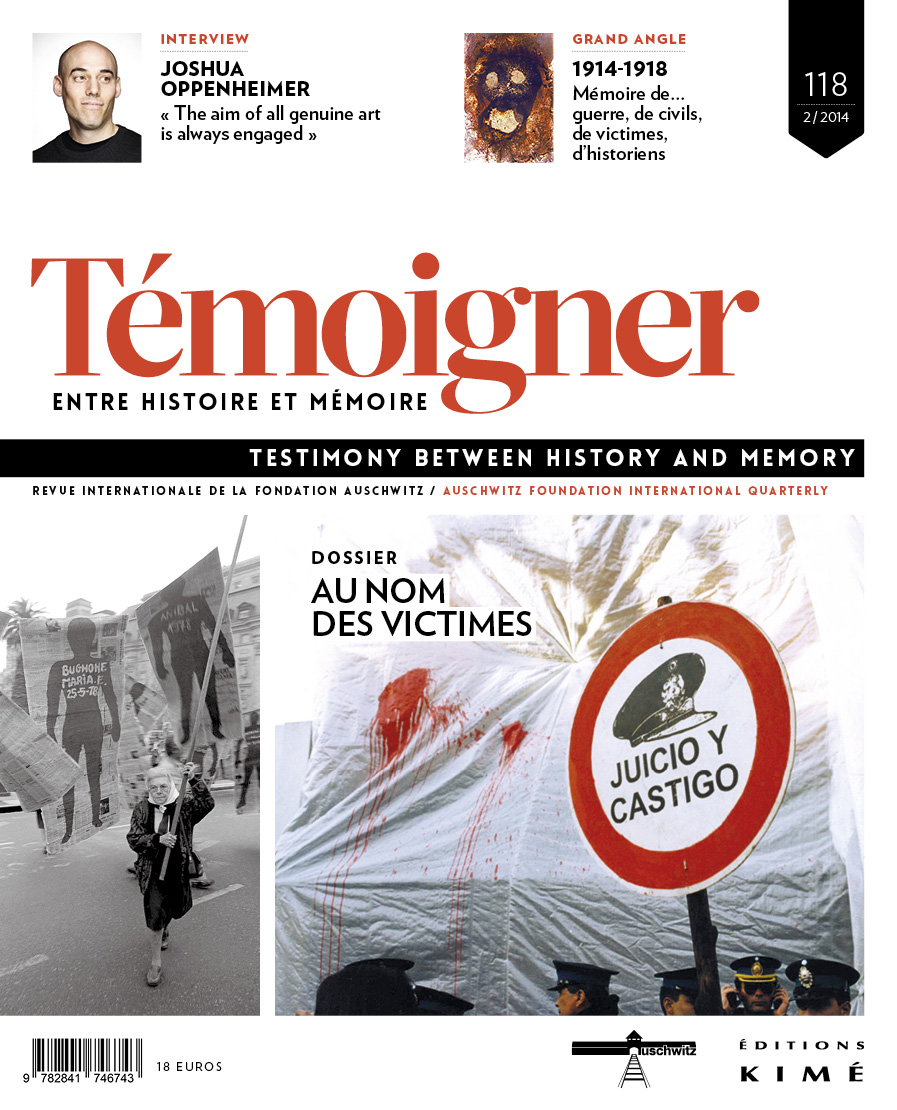
In the name of the victims. Dictatorship and State terror in Argentina, Chile and Uruguay
During the 1970s and 1980s, Argentina, Chile and Uruguay were in the grip of military dictatorships. The process of democratic transition that followed the long period of state terror involved the construction of particular narratives and memories, leading to a reconfiguration of the past. Despite local differences, this process is very much centered at the figure of the victim – a figure the articles in this dossier, collected by Claudia Feld, Luciana Messina and Nadia Tahir, set out to explore.
No. 117 (03/2014) Friends? Enemies? Relationships between memoriesAmis ? Ennemis ? Relations entre mémoires / Vriend of vijand? Hoe herinneringen zich tot elkaar verhouden [Friends? Enemies? Relationships between memories]
Much has been said and written about group memories, limiting their mutual relationships and history to conflicts, “wars”, competitions, or strategies for eclipsing or silencing. These terms have now become the platitudes of a kind of more general doxa about collective and cultural remembrance. This dossier proposes a critical reading of those terms and of that doxa by questioning the emergence, constitution, and inter-relating of different exemplary memories of the major violent episodes of the 20th century. It will address the relationships that those memories can maintain with other memories with which they share, if not the same event, at least similar characteristics and concerns.
No. 116 (09/2013) Memory tripsVoyages mémoriels / Herdenkingsreizen [Memory trips]
Should we fear what has been grouped under the term “memorial tourism”? Or should we take this as a reality of our time? Can any visitor, group or individual, nowadays be absorbed in the category of “tourist”? Or is this category a remote intellectual reduction of a personal experience that everyone is aiming during his visit? The problem appears in a somewhat different light when we think of tours for young people supervised by adults, usually teachers. This dossier gives the floor to historians and teachers with experience in the field.
No. 115 (03/2013) Memory construction in SpainL’Espagne en construction mémorielle / Spanje en de opbouw van de gedachtenis [Memory construction in Spain]
This dossier’s objective is to provide a benchmark for understanding the plural identities and relationships between memories and representation forms in contemporary Spain. Indeed, it is necessary today to take a fresh look not only on the stratified memories of the civil war, exile and the Franco repression, but also on the reception of other memories such as that of the Holocaust, and to propose new readings. We propose to highlight the conflicting or fruitful tensions between official actions, initiatives of associations and of artistic events.
No. 114 (12/2012) Memorial SitesSites mémoriels / Gedenkplaatsen [Memorial Sites]
Memorial sites constitute the concrete trace of European remembrance and history of the twentieth century. But what do they look like today? Exhibition and conservation criteria have changed during the last ten to fifteen years, like advances in historical research have changed the way we read and reconstruct past events. This is not only due to the fact that we have moved from a past history written by witnesses to a history written by professional historians. A new consciousness has emerged concerning transmission methods (memory education), and archeology has strengthened historical research. We tore off the veil of ideology that often influenced and prescribed the way we imagined permanent exhibitions, conservation and visits. Can we say we have entered a new era in memory transmission? It remains, in many ways, an open bet on the present and the future.
No. 113 (09/2012) The Taboos of German HistoryLes tabous de l'histoire allemande / De taboes van de Duitse geschiedenis The Taboos of German History]
The most painful or ambiguous periods in twentieth-century German history are characterized by numerous taboos, expressed in literature, photography and film as so many “returns of the repressed”. These studies focus in part on problems of antisemitism, and thus on the relationship of German-speaking societies to the Shoah. They also examine the way in which those societies confronted the violence they suffered, such as bombing, fleeing from the Red Army and the expulsions, and mass rapes.
No. 112 (06/2012) Children of the Spanish Civil WarLes enfants de la Guerre d'Espagne. Expériences et représentations culturelles / De kinderen van de Spaanse Burgeroorlog. Ervaringen en culturele voorstellingen [Children of the Spanish Civil War: Experiences and Cultural Representations]
The dossier in this issue deals with the experiences and cultural representations of childhood during the Spanish Civil War. It aims to help towards a better understanding of that conflict, which tore apart a population living on the same territory, by confronting the experiences of Spanish children who lived through it – as expressed in various forms during or after the war – with representations of those same children, particularly those coming from adults.
No. 111 (12/ 2011) Dangerous Game between Art and PropagandaArt & propagande : jeux inter-dits / Gevaarlijk spel tussen kunst en propaganda [Dangerous Game between Art and Propaganda]
Since the media came into existence, political institutions from political parties to governments have used them to promote their image, in order to win the support of the public they addressed. Authoritarian powers use the media as a means of consolidating their domination. But how can artists take part in propaganda, whose purposes are the opposite of those generally attributed to art? Does that mean setting aside their vocation, or do they themselves distort that vocation?
No. 110 (10/2011) Displacements, Deportations, ExileDéplacements, déportations, exils / Volksverhuizingen, deportaties, verbanningen [Displacements, Deportations, Exile]
States and criminal groups exploit population displacements to isolate or get rid of certain populations. In addition to being denied their normal rights, these populations lose visibility and are deprived of their reference points and social frameworks. In this way it is possible to make them the victims of constraints (deterritorialization, forced labor…) or violence (famine, massacres genocide…). These developments have spread on an unprecedented scale since the First World War and continue to grow worldwide. But there is also a dimension of remembrance to this reality: memories of these displacements are now being expressed in literature, and in exhibitions and museums. This dossier examines the contemporary double aspect of history and memory.
No. 109 (03/ 2011) 20th Century Wars and Genocides in Graphic Novels and Comic StripsLa bande dessinée dans l'orbe des guerres et des génocides du XXe siècle / Twintigste-eeuwse oorlogen en genociden in het stripverhaal [Twentieth Century Wars and Genocides as Portrayed in Graphic Novels and Comic Strips]
No. 108 (09/2010) How Documentaries Handle HistoryLe traitement de l'histoire dans les documentaires filmiques / De behandeling van de geschiedenis in de documentaire film [How Documentaries Handle History]
No. 104 (09/2009) Anti-fascism Revisited: History, Ideology, RemembranceL'Antifascisme revisité. Histoire – Idéologie – Mémoire / Nogmaals antifascisme. Geschiedenis, ideologie, gedachtenis [Anti-fascism Revisited: History, Ideology, Remembrance]
No. 103 (06/ 2009) Nazi Crimes and Genocides on the ScreenCrimes et génocides nazis à l'écran / Nazimisdaden en genociden op het scherm [Nazi Crimes and Genocides on the Screen]
No. 102 (03/ 2009) The Portrayal of Political Criminals in Films, Plays, Literature...Criminels politiques en représentation. Arts, cinéma, théâtre, littérature, médias / De representatie van politieke misdadigers. Kunst, film, theater, literatuur, media [The Portrayal of Political Criminals in Films and Plays, in Literature and in the Media]
No. 101 (12/2008) How to Educate, How to Remember?Quelle pédagogie, pour quelle(s) mémoire(s) ? / Welke pedagogie, voor welke herinnering(en)? [How to Educate, How to Remember?]
No. 100 (09/2008) Questions about the “Executioners”Questions de « bourreaux » / De kwestie van de “beul” [Questions about the “Executioners”]
Contact
Auschwitz Foundation – Remembrance of Auschwitz
Rue aux Laines 17 box 50 – B-1000 Brussels +32 (0)2 512 79 98
+32 (0)2 512 79 98 info@auschwitz.be
info@auschwitz.be
BCE/KBO Auschwitz Foundation: 0876787354
BCE/KBO Remembrance of Auschwitz: 0420667323
Office open from Monday to Friday 9:30am to 4:30pm.
Visit only by appointment.
![]()
![]()
![]()
![]()
![]()
Become a member
To become a member of Remembrance of Auschwitz ASBL, please contact us and transfer the sum of €50.00 to our account IBAN: BE55 3100 7805 1744 – BIC: BBRUBEBB with the communication: ‘Membership fee 2025’. The membership includes two issues of 2025 of our scientific journal.
DONATIONS
Donations of €40.00 or more (in one or more instalments) qualify for tax exemption for Belgian taxpayers.
In communication, please specify that it is a ‘Donation’ and mention your National Number which is required since 2024 to benefit from the tax exemption.
Subscribe
Error : Please select some lists in your AcyMailing module configuration for the field "Automatically subscribe to" and make sure the selected lists are enabled









































